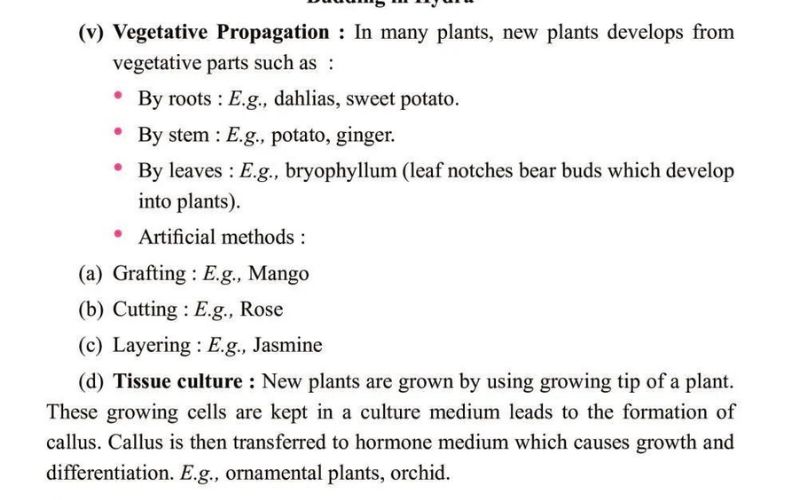Organisms Reproduce Class 10 Notes. Reproduction is a fundamental biological process by which organisms produce new individuals of the same species, ensuring the continuity of life. It is one of the most essential characteristics of living organisms. This process is crucial for the survival of species, as it allows for the transfer of genetic material from one generation to the next.
Types of Reproduction
Reproduction can be broadly classified into two types: asexual and sexual reproduction.
Asexual Reproduction
Asexual reproduction involves a single parent and does not involve the fusion of gametes. The offspring produced are genetically identical to the parent, known as clones. This type of reproduction is common in single-celled organisms, plants, and some animals. Several modes of asexual reproduction include:
- Binary Fission: This is a common method in unicellular organisms like bacteria and amoeba. The parent cell divides into two equal halves, each becoming a new individual. For example, in amoeba, the nucleus divides mitotically, followed by the division of cytoplasm, resulting in two daughter cells.
- Budding: In organisms like yeast and hydra, a new individual develops from a specific site of the parent organism. The new organism remains attached to the parent and detaches once it matures. In yeast, a small bud forms on the parent cell, grows, and eventually separates to form a new cell.
- Fragmentation: This method is observed in organisms like planaria and spirogyra. The parent organism breaks into fragments, each capable of growing into a new individual. For instance, in spirogyra, filamentous algae break into smaller pieces, and each piece grows into a new individual.
- Spore Formation: Fungi, algae, and some plants reproduce through spore formation. Spores are specialized cells that can develop into a new individual under favorable conditions. For example, bread mold (Rhizopus) produces spores in sporangia, which, when dispersed and germinated under suitable conditions, grow into new individuals.
- Vegetative Propagation: This is common in plants where new plants grow from parts of the parent plant like roots, stems, and leaves. Examples include the growth of new plants from the runners of strawberry plants, tubers of potatoes, and the leaves of Bryophyllum.
Sexual Reproduction
Sexual reproduction involves the fusion of male and female gametes, leading to offspring with genetic variation. This type of reproduction is common in most animals, plants, and some fungi. Sexual reproduction ensures genetic diversity, which is vital for evolution and adaptation. The main stages include:
- Formation of Gametes: Gametes are specialized reproductive cells. In animals, male gametes (sperms) are produced in the testes, and female gametes (ova) are produced in the ovaries. In plants, male gametes (pollen grains) are produced in the anthers, and female gametes (ovules) are produced in the ovary of the flower.
- Fertilization: Fertilization is the process where the male and female gametes fuse to form a zygote. This can occur internally (inside the body) or externally (outside the body). In humans, fertilization is internal, while in many aquatic animals like fish and amphibians, it is external.
- Development of the Embryo: The zygote undergoes multiple divisions and develops into an embryo. In animals, the embryo develops inside the female body or in an egg outside the body. In flowering plants, the zygote develops into a seed, which germinates to form a new plant.
- Growth of the Offspring: The embryo continues to grow and develop into a mature organism, capable of reproduction.
Reproduction in Plants
Plants reproduce both sexually and asexually, utilizing various structures and mechanisms.
Asexual Reproduction in Plants
- Vegetative Propagation: This involves the growth of new plants from parts of the parent plant. It can occur naturally or be induced artificially. Natural vegetative propagation occurs through structures like runners, tubers, rhizomes, and bulbs. Artificial methods include grafting, cutting, layering, and tissue culture.
- Spore Formation: Some plants, particularly non-flowering plants like ferns and mosses, reproduce through spores. These spores are usually produced in sporangia and can grow into new plants when they land in a suitable environment.
Sexual Reproduction in Plants
Sexual reproduction in plants involves the production of flowers, which are the reproductive organs.
- Structure of a Flower: A typical flower consists of sepals, petals, stamens (male reproductive part), and carpels (female reproductive part). The stamen contains anthers, where pollen grains (male gametes) are produced. The carpel contains the ovary, which houses ovules (female gametes).
- Pollination: Pollination is the transfer of pollen grains from the anther to the stigma of a flower. It can be of two types: self-pollination (within the same flower or plant) and cross-pollination (between different flowers or plants). Cross-pollination is facilitated by agents like wind, water, insects, and animals.
- Fertilization: After pollination, the pollen grain germinates on the stigma, forming a pollen tube that extends down to the ovary. The male gamete travels through the pollen tube and fuses with the female gamete (ovule) to form a zygote.
- Seed and Fruit Formation: The fertilized ovule develops into a seed, and the ovary matures into a fruit. The seed contains the embryo, which, under favorable conditions, germinates to form a new plant.
Reproduction in Animals
Animals reproduce primarily through sexual reproduction, involving the formation and fusion of gametes.
Human Reproductive System
The human reproductive system is specialized for sexual reproduction and consists of primary and secondary reproductive organs.
- Male Reproductive System: The primary organs are the testes, which produce sperm and the hormone testosterone. The secondary organs include the vas deferens, seminal vesicles, prostate gland, and penis, which aid in the storage, nourishment, and transport of sperm.
- Female Reproductive System: The primary organs are the ovaries, which produce ova and hormones like estrogen and progesterone. The secondary organs include the fallopian tubes, uterus, and vagina, which are involved in the transport of ova, fertilization, and nurturing of the developing embryo.
Fertilization and Development in Humans
- Fertilization: Fertilization occurs in the fallopian tube, where the sperm fuses with the ovum to form a zygote.
- Development of the Embryo: The zygote undergoes several cell divisions as it travels down the fallopian tube and implants itself in the uterine wall, developing into an embryo.
- Growth of the Fetus: The embryo develops into a fetus and continues to grow in the uterus for about nine months, receiving nourishment from the mother through the placenta.
- Birth: The mature fetus is delivered through the birth canal during childbirth, completing the reproductive cycle.
Advantages and Disadvantages of Asexual and Sexual Reproduction
Both asexual and sexual reproduction have their advantages and disadvantages.
Asexual Reproduction
Advantages:
- Rapid reproduction and colonization.
- No need for a mate, saving time and energy.
- Offspring are well-adapted to stable environments.
Disadvantages:
- Lack of genetic variation, leading to vulnerability to diseases and environmental changes.
- Overcrowding and competition due to rapid reproduction.
Sexual Reproduction
Advantages:
- Genetic variation among offspring, enhancing adaptability and survival.
- Evolutionary advantages through natural selection.
Disadvantages:
- Requires finding a mate, which can be time-consuming and energy-intensive.
- Slower process compared to asexual reproduction.
Conclusion
Reproduction is a vital biological process that ensures the continuity of life. Understanding the various modes of reproduction, their mechanisms, and their significance helps us appreciate the diversity and complexity of life forms. In the context of class 10 biology, a thorough understanding of reproduction lays the foundation for advanced studies in genetics, evolution, and ecology. By recognizing the importance of both asexual and sexual reproduction, we gain insights into the adaptive strategies organisms employ to survive and thrive in their environments.





